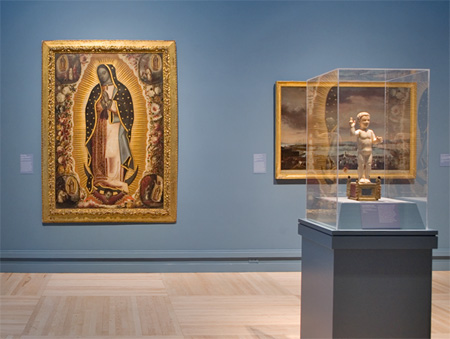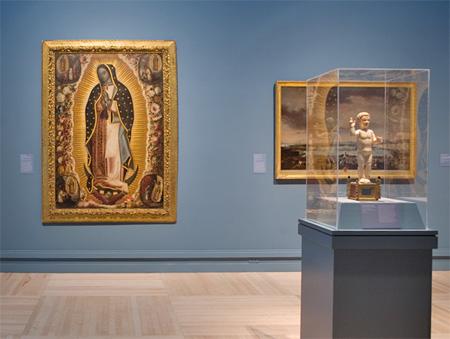
Last month we told you we had acquired Manuel Arellano’s 1691 painting Virgin of Guadalupe. Now we can report that it’s on view in our Latin American galleries. You may have seen Christopher Knight’s post at Culture Monster earlier this week, which also included a video of the original Virgin of Guadalupe, hanging in the Guadalupe Basilica in Mexico City.
You can see the Virgin of Guadalupe as soon as you enter the top floor of the Art of the Americas Building. It practically calls out to you, asking you to pass through three other galleries on your way to view it up close. But don’t pass too quickly! On your way you’ll pass Diego Rivera’s masterpiece Flower Day and our other recent acquisition, Roberto Matta’s Burn, Baby, Burn.
Speaking personally, probably one of the most valuable things I’ve gotten from working at LACMA in the last few years has been an appreciation for Latin American art—all eras and all varieties. It started, for me, with the mesmerizing Arts in Latin America, 1492–1820, a special exhibition from 2007. It was one of those rare exhibitions that knocked me off my feet precisely because I walked in with no expectations—I didn’t think it would be “my thing.” I was wrong. Then we reinstalled the ancient American galleries with the help of a gallery design by Jorge Pardo. The installation was controversial —does the design distract from the objects? Mine is just one opinion, but if you ask me, no. Pardo’s gallery design made me look at the objects with fresh eyes, made me consider the stylistic choices these ancient artists were making compared to those working at the same time in, say, Europe or the Middle East. Sure, you could make that comparison without Pardo’s help—the differences were always there—but I hadn’t taken the time before. Again, it wasn’t “my thing” until I saw it in this new light.
At the same time, we reinstalled our permanent collection of Latin American art from the Spanish colonial era to the twentieth and twenty-first centuries. Walking through these galleries again yesterday, on the way to see the Virgin of Guadalupe, I was reminded again how much this collection impresses me. The Matta, the paintings by Rivera and Tamayo, the religious-themed paintings sharing the gallery with Arellano’s Virgin. And then there’s the contemporary gallery, which features probably three or four of my favorite twentieth and twenty-first–century works in the whole museum, including works by Francis Alÿs, Cildo Meireles, Mathias Goeritz, and Jesús Rafael Soto (visitors to the museum making a point to hit up BCAM and the Ahmanson Building’s modern galleries would do well not to forget about this gallery).
The new acquisition of the Arellano’s Virgin of Guadalupe is reason enough to come up to these galleries—just be sure you take in everything else while you’re here.



